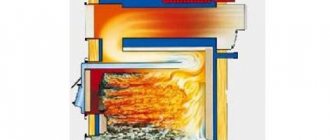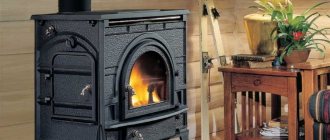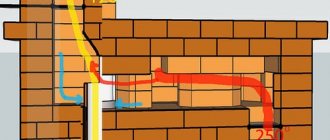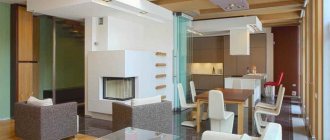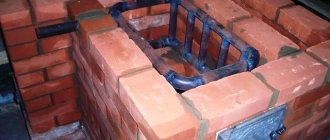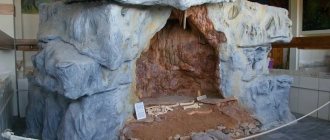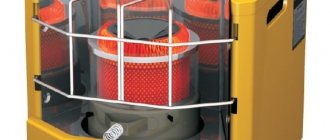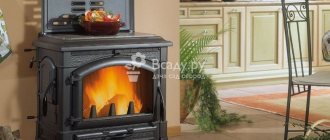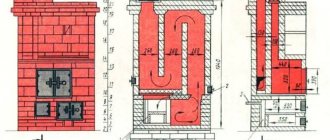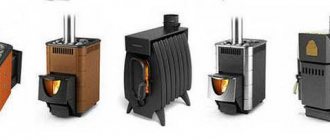Design features of coal furnaces
If you look closely at a coal stove and its most common wood-burning competitor, then, in principle, it will be difficult to find any special differences at first glance. But upon closer examination and familiarization with the operating principle of the furnace itself, it becomes clear that they differ fundamentally. (See also: Do-it-yourself housekeeper oven)
- The principle of combustion and air supply differs; if for wood-burning stoves the most efficient combustion can be achieved when air is supplied directly to the place of fuel combustion from above, then for coal stoves it is necessary to purify the fuel and supply the air mixture from below.
For wood-burning stoves, the use of dry fuel during the combustion process is not particularly critical. It is only important that the initial lighting of the stove occurs with dry material. Before adding coal to the furnace, it is advisable to preheat it in a special compartment of the furnace, which is heated by exhaust gases.
The design of the chimney for a coal-fired stove is somewhat different from its wood-burning counterparts and is designed for a higher air flow rate. And the flow itself and its speed are regulated not by a blower, but by a blower. The damper itself, blocking the chimney (yushka), is completely absent. This feature is due to the fact that coal stoves smolder for a very long time, and do not quickly burn through fuel like wood stoves. The disadvantages of coal stoves are also associated with this feature:
- It is impossible to block the chimney to prevent the weathering of heat due to the danger of carbon monoxide poisoning, and therefore coal heating stoves cool down quite quickly.
- For normal combustion of a coal furnace, it is advisable to exclude the presence of combustion products in its lower compartment. To do this, it is necessary to periodically clean the ashpit, which will be constantly replenished with burnt coal. In this case, cleaning must occur more often than is necessary for a wood stove.
The walls of coal stoves must withstand higher temperatures than conventional wood stoves; accordingly, they will be thicker, and more heat-resistant materials must be used for their assembly.
(See also: DIY camp stove)
A coal stove may have a special design for loading fuel, this is due to the higher ignition temperature of coal - that is, it will not be possible to light such a stove with just a piece of newspaper and matches. Therefore, in a coal stove, firewood is first lit, and coal is loaded on top, which gradually flares up as the wood burns out.
In practice, combination stoves are often used, in which both coal and wood can be burned simultaneously. In addition, peat briquettes, which burn very much like coal, can also be used as fuel. In combined devices, all elements of both a coal and wood stove are simultaneously present.
Device
A DIY coal stove includes the following elements:
- blower;
- firebox;
- chamber for drying fuel;
- chimney.
The design of the firebox and chimney differs from analogs that burn wood. The firebox has two compartments. In one compartment, firewood is lit, in the other, coal is dried. Once the temperature is sufficient, the coal also begins to burn. This is due to the fact that coal has a fairly high combustion temperature and it is simply impossible to light the stove using the standard method.
A combination firebox is often used, which can operate on both wood and coal. This option is the most rational for a coal stove for heating a home.
Coal
Coal is a traditional raw material for solid fuel boilers. It burns for a long time and has good heat transfer, but only if it is correctly placed in the combustion chamber, properly ignited and subsequently maintained.
Coal selection
To increase the efficiency of the boiler and extend its service life, it is necessary to take into account the manufacturer’s recommendations for choosing the grade of coal. Usually the name of the brand and its fraction are indicated in the technical data sheet of the device. Each grade has a different ratio of carbon and impurities, different humidity, structure, strength and age of formation.
The most popular types of coal for solid fuel boilers:
- Coal. The heat transfer of the fuel is 5500 kcal/kg. The average percentage of carbon and ash is 75%/3%. Suitable for igniting most classic boiler models.
- Anthracite. Specific heat indicators are 9000 kcal/hour. The percentage of carbon is no more than 7%. The disadvantage of this variety is difficulty in ignition and extremely high combustion temperature.
The most popular and convenient for ignition is long-flame coal. This universal fuel for all types of boilers ignites quickly, burns for a long time and releases a large amount of energy.
Brown coal and lingite can be found on sale. However, these varieties are recommended for use only on an industrial scale due to the large amount of ash residue and high humidity levels.
How to fire a boiler with coal
The solid fuel installation consists of two main chambers: the upper one is used to store fuel, and the lower one (ash pan) is used to collect ash and slag. As the fuel burns in the main chamber, the combustion products gradually fall into the ash pan, from where they are removed manually.
Before starting melting, it is necessary to prepare the installation for operation. To do this, solid combustion products are removed from the ash pan, the walls of the combustion chamber are wiped and the chimney channels are cleaned.
As soon as the preparatory work is completed, you can begin loading fuel and igniting.
- Place dry paper on the grid of the main chamber. It is recommended to crumple it up first - this way it will light faster.
- Place wood chips and brushwood evenly on top in the shape of a well or hut.
- Light a match and bring it to the paper from different sides - the paper will burn evenly, involving wood chips in the process.
- Close the firebox door and open the ash pan valve to allow oxygen to enter. At this stage, you will have to monitor the combustion process of the wood chips. You can adjust the intensity using the ash pan (ash pan) door.
- As soon as the wood chips burn completely, pour a small layer of fine coal on top. Its amount should not exceed a third of the combustion chamber.
- After loading the first batch of coal, close the door again to achieve maximum combustion temperature. This usually takes about
- When the first layer of fuel completely engulfs the flame, add the remaining coal to the upper border of the door. It is recommended to stir the burning coal slightly beforehand.
- Close the blower door halfway. If there is strong smoking, leave a small crack.
As combustion proceeds, fuel is added in small portions to the main chamber, each time closing the ash pan damper. You should not put in a large amount of coal at once - this will lead to the fuel solidifying on the grate and its premature deterioration.
Charcoal stoves
We produce charcoal stoves of the Charodeyka and Champion . Small charcoal burning furnaces have a unique design, which ensures environmental safety and high productivity, the ability to produce high-quality charcoal on an industrial scale.
Design of a charcoal kiln
The Champion and Enchantress charcoal stoves use a wood-burning stove built inside the chamber as a heat source. This ensures small dimensions and allows you to maintain high performance.
Due to the tightness of the chambers and the lack of contact with flue gases, the output produces high-quality products with a minimum ash content.
Charcoal kilns are a sealed chamber with a thermal jacket made of non-combustible materials. Heating of the material occurs due to radiant heat emanating from the walls of the chamber, which is heated by hot flue gases generated as a result of fuel combustion.
Operating principle of charcoal kiln
Charcoal is obtained by pyrolysis of wood without oxygen. Charodeyka and Champion charcoal are equipped with a system for removing moisture and afterburning gases with an additional cleaning system. To allow the vapor-gas mixture to escape during the process of recharring wood, outlet channels are provided.
The quality of raw materials for the production of charcoal is regulated by GOST 24260-80. To produce charcoal, soft, medium and hard wood is used.
This equipment configuration can also be successfully used for drying firewood or timber. Firewood consumption depends on the moisture content of the material and the speed of movement of the working coolant in the stove chimney.
The duty cycle is the time spent drying and pyrolyzing wood. The operating cycle depends on the parameters of the raw materials, the humidity of the raw materials and fuel, and climatic conditions. The yield of coal depends on the parameters of the raw materials, the moisture content of the raw materials, and the type of wood.
Mobile charcoal kiln
of the Champion and Charodeyka charcoal kilns is achieved through additional equipment. At the customer's request, the furnaces can be equipped with metal skids for moving over short distances using tractors and trucks without lifting.
Sale of charcoal kilns
Our company sells charcoal kilns of various modifications. All stoves manufactured in our production are certified.
Send a request through the form on the website and our managers will be able to select the appropriate equipment for the production of charcoal for you, answer your questions, send photos and videos of charcoal kilns, and calculate the payback period for investments.
Charcoal kilns price
Charcoal kiln Enchantress 4.5:
- volume 1 chamber 4.5 cubic meters. m
- heat source: stove built inside the chamber (wood-burning)
- coal output: up to 0.5 tons per cycle
- 247,000 rubles
Charcoal kiln Enchantress 10:
- volume 1 chamber 10 cubic meters. m
- heat source: stove built inside the chamber (wood-burning)
- coal output: up to 1.7 tons per day
- 412,000 rubles
Charcoal kiln Champion:
- volume 1 chamber 3 cubic meters m
- heat source: stove built inside the chamber (wood-burning)
- coal output: up to 0.4 tons per cycle
- 215,000 rubles
Charcoal production as a business
Charcoal is in demand on the market. It is used both in private households for cooking meat and other products on the grill, and in small street cafes, restaurants, camp sites and recreation centers. Charcoal is also an excellent adsorbent material, which is used for the production of filters and in pharmacology.
You can start a charcoal business by purchasing a small charcoal kiln. Once the technology has been developed, workers have been trained, and all the intricacies of manufacturing a high-quality finished product have been studied in practice, the business can easily be expanded. To do this, it is enough to install several small charcoal kilns or purchase a charcoal burning complex, which will allow you to organize continuous production of charcoal.
The Champion and Charodeyka charcoal kilns are perfect for starting your business. These are small stoves that are easy to use and affordable. They will allow you to get acquainted with the technology of making charcoal and learn how to make a quality product for sale from scratch. Even without experience and knowledge, after completing training in our company, you will be able to organize your own business and receive a good regular income.
Firewood
Firewood is another popular type of fuel for boilers. Only dried wood is suitable for burning. Under-dried firewood in the firebox begins to release moisture, which accumulates on the internal surfaces of the firebox and chimney. In combination with smoke and carbon monoxide, tar is formed - it reduces the operational properties of the boiler and reduces the permeability of exhaust gases.
Firewood selection
For melting, hardwood with a long burning life and slow heat transfer is optimal. Preference should be given to deciduous trees over coniferous ones. During the combustion process, conifers emit a large amount of resinous substances and quickly pollute the combustion chamber and heat exchanger.
According to the degree of hardness, wood species are divided into 3 categories:
- hard - white acacia, ash, beech, oak, maple, yew, hazel, pear;
- medium hard - walnut, alder, sycamore, birch, cherry, cherry, cedar;
- soft - poplar, aspen.
How to heat a boiler with wood
- At the first stage, it is necessary to warm up the heating device well. This will prevent smoke from leaking into the room. Sheets of paper are placed at the bottom of the fuel chamber, on them are flammable birch bark, chips and splinters, and on top are small logs (up to 15 cm in diameter). The space between the chips can be filled with paper for faster ignition.
- When the firebox is about half full, you should set fire to the paper and open the ash pan valve for better draft. Close the main chamber door.
- When the chamber and chimney warm up and the preparatory filling begins to burn out, the firebox can be filled with large firewood. You can lay out the logs in a row or in the form of a well, leaving gaps between them for air penetration.
- As the firewood burns out, you will need to make a new stack without waiting for the previous one to die out.
Long-burning boilers greatly simplify the work. Fuel is added to them once every 6 hours due to automatic regulation of draft and combustion process. Such devices should be melted in accordance with the attached instructions.
How to calculate coal consumption
Coal consumption in a solid fuel boiler depends on many factors. Costs are affected by:
- Heated area.
- Amount of heat loss.
- Ambient temperature.
Exact costs can only be calculated after the end of the heating season. Moreover, depending on the winter, the average consumption of coal for heating can vary from 8 to 15 tons (for a building of 200 m²).
If you make average calculations based on actual operating experience, you can obtain the following data:
- Costs for September – October will be 1 bucket per day.
- Fuel consumption rates in a coal boiler from November to February will increase to 10 buckets per day.
- In March and April, you will need to burn 1-2 buckets per day.
Calculating the coal consumption for a 20 kW boiler, using the above data, will show that the costs during the heating season will be 580 buckets or 10-10.5 tons.
Coal combustion process
Let us remind those who have forgotten, we will teach those who do not know how to light a stove with coal. The following stages of firing a furnace with coal can be distinguished:
Advice! Do not rush to part with coal dust, as it is an excellent fuel.
- Prepare coal.
- Take crumpled newspaper or other paper and place it in the firebox. Ignition can also be accomplished using wood shavings.
- Place 10-12 wood chips, for example pine or birch, on top in the shape of a well or hut. It is necessary to ensure that air can circulate freely between the firewood and the paper, which will promote more efficient combustion.
- Set the newspaper on fire.
- Close the door and at the same time open the ash pan, with which you can regulate the combustion process.
- After the wood has burned, pour fine coal on top with a layer thickness of approximately 12-15 cm.
- After the fuel burns strongly, you can continue to use fine coal, or you can pour larger coal into the firebox in a layer 20-25 cm thick (depending on the dimensions of the combustion chamber).
Important! Until the coal begins to burn well, it needs to be stirred a little from time to time to improve air circulation and prevent the formation of a homogeneous sintered mass.
To prevent smoke from entering the room, during the next addition of fuel, you should close the vent with the door open.
Advice! If the metal stove is equipped with burners, then it is better to pour coal through them.
How to do it yourself
- The design of a brick stove burning coal or briquettes is quite simple; you just need to meet two conditions:
the firebox must be made of refractory bricks; The stove must be equipped with cleaning systems in all areas of the chimney.
The ordering diagram of a universal oven is shown in the figure. Thanks to a simple device, you can do it yourself, even without experience. The stove is small in size and can be used to heat a country house or village house with an area of up to 36 square meters, consisting of one or two rooms. In the latter case, the firebox is located on the kitchen side, and the back wall, which heats up during the fire, is brought into the room.
The stove consists of a firebox, lined with your own hands from refractory fireclay bricks, and a firebox channel with one cover.
Flue gases are retained in the channel, a cap effect is created, and the furnace body warms up. After cooling, the smoke descends and exits through the chimney. It is equipped with two valves that eliminate sharp boundaries between warm and cold air and moisture condensation.
Below the firebox there is a ash pan combined with an ash pan. Pressurization is carried out through a grate; air movement is ensured by a simple chimney design and good draft.
- The furnace is installed on a free-standing foundation made of reinforced concrete. The dimensions of the foundation should be 5-10 cm larger than the dimensions of the furnace, its height should be 50-70 cm, and it should be 15 cm below the level of the finished floor covering. After the foundation has been poured and dried, it is leveled with cement mortar, two layers of roofing felt or other rolled waterproofing are laid on it, after which they begin laying the furnace with their own hands.
- They lay out two rows of brick - the base of the stove, in solid masonry with a bandage of red brick. They are placed on cement mortar.
- Next, the masonry is carried out in accordance with the diagram using a solution of fireclay clay. The first row forms the bottom of the ash pan.
- In the second and third rows, place the blower door, securing it with annealed wire placed between the bricks.
- The fourth row forms the overlap of the ash chamber and an opening for blowing and removing ash from the firebox.
- Starting from the fifth row, the laying is done with fireclay bricks. A grate is laid in the fifth row.
- In the sixth and seventh, the firebox door is installed in the same way as the blower door.
- Rows 9 to 11 form the walls of the firebox; they are placed with a bandage.
- In the 12th row, a vault is made from ¾ of the brick, and in rows 13 and 14, the vault is covered.
- In the 15th row, a cleaning door and a cover are installed.
- Starting from the 16th row, the masonry is again made of red brick. Smoke channels are laid out according to the diagram.
- Valves are installed in rows 25 and 32.
- Rows 33 and 34 complete the overlap of the stove, then lay out the chimney of the required height.
- The stove is dried in air, then carefully heated in multi-steps, first with wood, and after several fireboxes - with coal. During operation, it is allowed to use any solid fuel: coal, anthracite, firewood and wood waste, pellets and briquettes.
Any metal stove with a long-burning effect can be used to fire coal. by laying out a fireclay brick lining in the firebox with your own hands and equipping the vent with a fan. With this modification, the metal of the furnace will not burn out from high temperatures, and the coal will burn steadily for a long time.
What kind of coal should be used to heat a brick stove?
The brick stove we all know for burning wood is strikingly different in its design from stoves designed for heating rooms with coal. There are specialists involved in the stove business who, along with the skills of filigree bricklaying, must know what kind of stove, what type of coal and how to properly heat it, as well as maintain it in good condition.
Design features of furnaces
The main difference between a coal stove and a wood stove lies in its design, namely, the air supply system, located so that it enters the throat from below. If we compare both types of stoves, then the combustion walls of a coal stove must be thicker than those of a wood stove. Often, special water boilers are placed near such furnaces to prevent overheating. This is due to the fact that the combustion temperature of coal is an order of magnitude higher than that of wood.
Naturally, the thickness of the walls is not the only difference. They also differ in the design of the hood and the location of individual parts of the stove structure relative to each other. These include the ash pan, grate and other elements. However, there are universal stoves suitable for any type of solid fuel, which combine the characteristic features of both types of stoves.
Classification and characteristics of coal
Before touching on the topic of choosing coal for the stove, it is worth carefully understanding the classification of this type of solid fuel. It is worth noting that the quality of the coal itself is determined by the following indicators:
- heat of combustion;
- ash content;
- humidity;
- release of volatile substances;
- sulfur content.
The first indicator - calorific value or, as experts call it - calorie content, is one of the main qualitative characteristics of a mineral. Therefore, the higher it is, the better and you should buy this particular coal, which is anthracite, which is marked in Russia under the letter “A”. The calorie content of this coal is 8750 kcal per 1 kg of fuel. It is worth noting that other popular types of coal are coke (8400 kcal) and brown (6900 kcal).
Ash content (the presence of non-burning additives in coal rock) is a significant indicator of coal quality. Mineral admixture is the content of elements that affect the parameters of coal. For different brands of coal, their content may be different. Accordingly, if a brand has a lower percentage of ash content, then this coal contains fewer impurities, and the coal itself is cleaner and of higher quality. The lowest standard for ash content of quality coal is 25%. For low grade, this degree is about 40%. It is worth noting that the ash content directly depends on the frequency of chimney cleaning.
The moisture content of the rock (surface and internal) is an equally important characteristic, because the higher the water content, the worse the quality of the coal. External humidity is affected by the room in which the product is stored and can be influenced simply by drying it, but the internal liquid content cannot be changed. Humidity is determined simply: in winter the pieces of coal are frozen, and in summer they are stuck together. This indicates a high water content.
The last two significantly affect the quality of coal to a lesser extent than the previous three. It is only worth noting that the sulfur content is an indicator of the harmfulness of the product, the norm of which is in the range of 0.2 - 0.6%. And the yield of volatile substances determines how the coal behaves during the combustion process.
How to choose coal
Deciding what kind of coal to burn is quite easy. In this case, everything depends only on the desires and financial capabilities of the buyer. Anthracite coal is the highest quality of all types, having high heat transfer and a small amount of impurities. Naturally, with such high rates, the main negative quality will be the clearly inflated price of the product. But coconut and brown coals are no worse suited than anthracite for heating stoves and heating small rooms. Moreover, lignite is widespread and has a low price.
To understand the required type and volume of coal that will be required in winter to heat 1 m² of space in one day, you need to know the difference between the thermal conductivity of these three types of coal. And then multiply the indicator by the number of meters in the room and the days of the heating season.
- anthracite – 0.15 kg/day;
- hard coal – 0.19 kg/day;
- brown coal – 0.32 kg/day.
However, despite the fact that the heat generation of anthracite is many times greater than that of brown coal, most homeowners rely on brown or coke coal due to its affordable price. Regardless of the type of coal chosen, it can be used to heat any stove designed for this purpose.
Any of the types of coal considered do an excellent job of heating rooms using any boiler that runs on solid fuel. If you have not yet decided which type of coal to choose, we recommend calling our managers back, who will tell you about the fractions and brands of this mineral and help with your choice.
Our offer
You can buy inexpensive coal of almost any fraction, type and brand in ours. We are ready to supply you with any volume of this mineral, depending on your preferences. You can find out the cost of coal by contacting our company office or by calling +7 (391) 240-99-79 . We remind you that we work seven days a week and without a lunch break from 0800 to 2200.
See also:
Homemade potbelly stove
Recently, many designers have been offering exclusive versions of potbelly stoves or fireplace stoves that are installed in country houses. For residents of prestigious cottages, they are not only an additional source of heat, but also a beautiful accessory for the interior design of the room. Such individual stoves fill the room with warmth and special comfort. Firewood crackling in a stove or fireplace looks very beautiful and romantic when a winter blizzard is raging outside the window.
The most popular, primitive and effective long-burning stove for temporary heating is the well-known potbelly stove. Its simple design is based on the “symbiosis” of a Russian stove and fireplace. With one load of fuel, it is capable of maintaining a comfortable indoor temperature for 4 hours. The potbelly stove can be installed in any space where a chimney can be removed.
Today, anyone who has the skills to perform plumbing work can make a potbelly stove with their own hands from all kinds of available materials. This oven:
- Does not depend on electricity or gas.
- Easy to maintain and operate.
- Allows you to control the combustion process.
- Takes up little space.
- Compact and economical.
- May have a hole for installing utensils to cook food or heat water.
Among the disadvantages of such a furnace, it should be noted the low efficiency, high speed of exhaust gases and rapid cooling. Therefore, to maintain the temperature in the room, it must be heated constantly.
The following can be used as fuel for a potbelly stove:
Materials and equipment for independent work
Our craftsmen make potbelly stoves with a welding machine on hand and used:
- large cans;
- metal corners;
- wide pipes;
- gas cylinders;
- metal boxes;
- large fire extinguishers;
- old barrels;
- steel sheets;
- chimney pipes;
- metal gratings.
For ease of work, you can also use factory-produced technical fittings in the form of:
Main elements of the combustion unit
Detailed drawings are not needed to make a potbelly stove. The main thing is to get the most efficient design possible. Let's look at the main components that make up a homemade stove.
Combustion chamber
It is the combustion chamber that performs the function of heat transfer. The larger the outer surface area, the better.
It is important that the bottom of the chamber has sufficient area to place firewood or coal there. Therefore, cylindrical homemade devices are placed on their sides
Rectangular ovens are designed in a horizontal design with a minimum size of 250x350 mm.
Large stoves made from barrels or gas cylinders are also practical in a vertical position.
Type of finished product
An additional ash pan welded or screwed to the bottom of the structure is convenient for selecting ash. Its arrangement with a blower promotes better heat generation, and the lower door ensures the supply of the required amount of oxygen and regulation of combustion intensity.
Doors and openings
These elements are made with your own hands from the leftover metal after cutting out the openings. After all, the scraps from the cylinders repeat the bend of the surface, and this is very important in work. Steel door canopies are attached to the body by welding, and then the doors themselves are hung on them.
Here it is necessary to provide a locking device, which can be made like a guillotine bolt or bolt.
The optimal openings for the firebox have dimensions of 250x250 mm, for the blower - a height of 100 and a width of 250 mm. Canopies are installed on one vertical axis. A distance of approximately 10 centimeters is maintained between the openings. To prevent coals from falling out of the door, the firebox opening is located slightly above the level of the grate.
To remove flue gases in a potbelly stove, a steel pipe with a diameter of 100–150 mm is used. The pipe itself is not insulated - it serves as an additional source of heat. And for better heat transfer, it is placed towards the outlet with inclined or horizontal sections, thereby increasing the path of warm gases.
The outlet pipe for connecting the chimney is located on top or, preferably, on the side. The latter option slows down the removal of gases, leaving space for the cooking zone.
Note! In the chimney, to regulate the intensity of removal of hot gases, it is advisable to use a rotary or guide valve
Modern coal stoves for home description, types
A coal stove for the home has many advantages. The main ones are ease of operation and maintenance, the possibility of using another type of solid fuel instead of coal, and high heat capacity. And besides, such a coal-heated stove for a country house can be made of different materials.
A coal stove has high efficiency levels (about 60 percent, which corresponds to boilers for heating systems that use liquid fuel). Modern models allow you to control the combustion of coal in the furnace and regulate this process for a more rational use of fuel and heat.
Modern coal-fired stoves come in several types, depending on their purpose:
- heating stoves;
- heating and cooking stoves;
- household;
- stoves-fireplaces.
Modern stoves are made from different materials: refractory brick, cast iron, steel, soapstone, etc.
Feasibility of installation
Some owners of gas boilers do not see the point in installing an additional source of heating at home - a coal stove. Others think it's mandatory. To understand which of them is right, you need to highlight the possible risks when operating heating systems (HC) without a backup energy source:
- accident on the gas main or in the local network;
- lack of heating power in extreme frosts;
- problems with the boiler itself.
The price of a modular protection system with automatic input of a backup heating source may not be affordable for the owner of a private house, while a coal stove is a completely affordable alternative.
There is generally no point in equipping a cottage or hunting lodge with a CO with a water circuit. Even if you visit there consistently once a week, but at the same time regularly heat your empty house all winter, the expenses will be completely unjustified. In small houses with a maximum of three heated rooms, a fireplace or stove will also be more appropriate than a boiler.
Many potential buyers are frightened by the lack of automation capabilities for heating devices of this type. If you do not agree to serve as a stoker around the clock, take a look at long-burning coal stoves for your home. These devices can work up to 8 hours on one load, and their efficiency is close to 90%.
Is it possible to heat with coal?
Many owners of stove-heated homes are wondering: is it possible to use coal instead of firewood in a brick stove? Will it burn as efficiently as in industrial boilers?
The process of coal combustion occurs with the release of a large amount of heat; the temperature in the firebox is much higher than when burning wood. At the same time, the smoke coming out of the firebox is less hot than when burning wood.
For this reason, a conventional stove with long smoke channels cannot be fired with coal: the smoke entering the chimney will have too low a temperature, which will lead to the formation of condensation and soot. When they interact, they form carbonic acid, which destroys the bricks, which can ultimately cause a fire.
In addition, increased temperature in the firebox can cause its destruction. The firebox for a coal stove made of bricks must be made only from fireclay bricks, and the walls of the stove in this place must be thicker for high-quality heat removal and accumulation.
It is not recommended to burn an ordinary Russian stove with coal. having an unlined firebox and extended smoke channels! This will lead to the gradual destruction of the oven elements!
In which ovens can you burn coal?
Since, as a result of combustion, coal produces a higher temperature than wood fuel, stoves for combustible stone (black gold) are slightly different from wood-burning designs.
Although, you can burn with coal using an ordinary brick oven, but only with thickened walls and a 2-row grate. Plus, such a heating structure must be equipped with an additional hood that would not be connected to other channels.
There are designs with two water boilers in the furnace, with the help of which not only the room is heated, but also the brickwork is significantly cooled. Such devices require special supervision, since they must constantly contain water.
Plus, the dimensions of the grate and ash pan must be identical, otherwise there may be significant heat losses.
It will be interesting! Instructions on how to make a bell-type stove.
Other types of boiler fuel
Alternative types of fuel can be used to operate a solid fuel boiler.
Coal briquettes. The fuel is produced by pressing small fractions of coal and coal dust. They use minerals or coal tar as a binder. The advantages of this type of fuel are ease of installation and kindling, high calorific values and excellent flammability.
Pressed peat or wooden eurobriquettes. Fuel briquettes made from peat have a small area, but are capable of smoldering for a long time, maintaining the active combustion phase.
Pellets. This is biofuel made in the form of granules. Peat, wood and agricultural waste are used for production. This is an environmentally friendly and energy-efficient material, which is preferable to use in boilers whose design is adapted to pellets.
How to choose
Advantages of long-burning steel boilers:
- one-piece welded structure, not subject to leaks;
- rapid heating and cooling of the boiler walls and heat exchanger;
- Full automation is possible due to low inertia;
- less weight;
- reasonable price.
Disadvantages of steel models:
- susceptibility to corrosion, especially in welding areas;
- steel boilers cannot be repaired; in case of through corrosion and leaks, the unit is replaced with a new one.
The advantages of long-burning cast iron boilers include:
- resistance of cast iron to corrosion;
- the design of the heat exchanger from separate sections allows for partial replacement in case of damage;
- cast iron is a brittle and non-plastic material; in the event of a sudden change in temperature, cracks and destruction are possible;
- higher price than steel models;
- cast iron boilers are much heavier - 1.5-2.5 times.
Load volume and automation The frequency of filling the combustion chamber with coal depends on this characteristic. It is worth analyzing whether it will be convenient to load coal several times a day, or whether it is better to give preference to models with a large loading volume. The record holders for operating time are top-burning shaft-type boilers. They occupy a small area, while their loading chamber is quite large, and some models can heat a house for 5 days on anthracite and 3 days on brown coal on one load. Mine boilers are usually equipped with microcontrollers, which make it possible to automate the entire process and reduce maintenance to a minimum. Bottom-loading boilers, as a rule, are equipped with a smaller firebox, and they are much cheaper than mine boilers and are easier to use. Such boilers usually do not have a blower fan, and air flow occurs due to draft. The chimney for such a boiler should be as simple as possible and have a total length of no more than 5 meters. The advantages of boilers without draft are independence from electricity and low price. Disadvantages - low level of automation. Fully automated models with a loading hopper that can hold a multi-day amount of fuel require the least attention and maintenance. Their price, of course, is high, but they have a number of advantages that provide worry-free heating throughout the season:
- fuel supply mechanism equipped with a agitator;
- built-in and remote sensors that control the combustion process;
- emergency valves that prevent boiling;
- SMS alarm mode;
- combustion function and standby mode;
- DHW circuit.
Boiler maintenance comes down to loading the bunker at the beginning of the season and setting the parameters of the required mode.
Video: automated boiler with hopper
Choosing and purchasing a boiler is not an easy task, and given the cost of modern models, it is also expensive. Therefore, for small private or country houses, you can evaluate your strength and make a coal stove with your own hands.
Preparatory stage of lighting the stove
If you are planning to light a stove that has not been used for a long time, you should carry out a number of preparatory measures.
This procedure must be carried out in order to ensure trouble-free operation of the stove, as well as to avoid unpleasant situations that sometimes lead to fires or harm to human health and life. • Inspect for cracks. Their presence can facilitate the penetration of smoke and even carbon monoxide into the room. If any are found, minor repairs should be immediately carried out using a mixture of clay and sand. • Clean soot from all flues and chimneys. Wipe off dust from the internal walls with a dry rag so as not to smell a bad aroma when kindling. In general, it is advisable to perform this procedure 2-3 times a month.
• Pay attention to the doors, especially their fit and the functionality of the locking mechanisms, to avoid the appearance of smoke. • Select fuel of the appropriate quality, suitable specifically for your type of stove
• Properly equip solid fuel storage areas.
During further operation, you should also follow a number of simple rules. Using plastic, construction and household waste for kindling will lead to severe contamination of the stove. It is incorrect to open the vent and the oven door at the same time. It should be heated several times a day for one and a half to two hours to avoid overheating. Dry, medium-sized, dust-free charcoal will provide excellent functionality.
Avoid storing flammable objects near hot walls. Do not leave the stove unattended while lighting, especially in homes with children.
